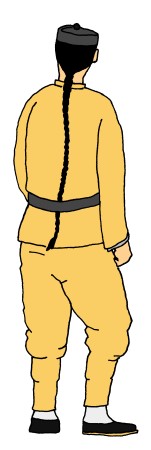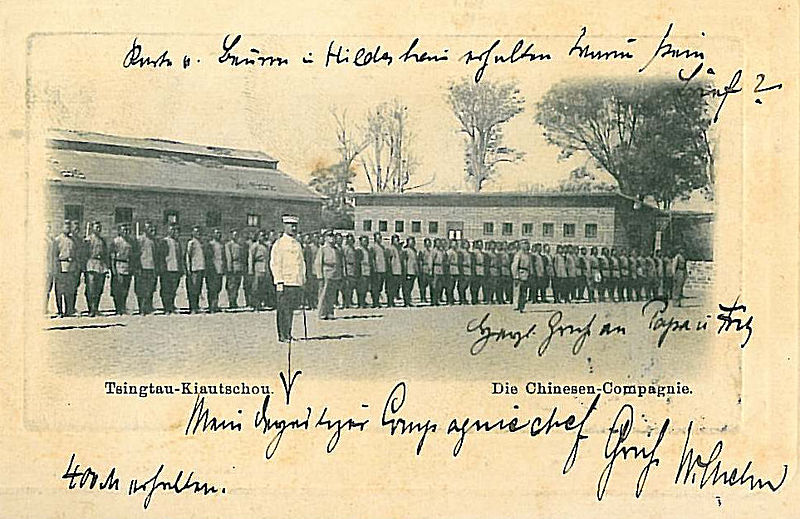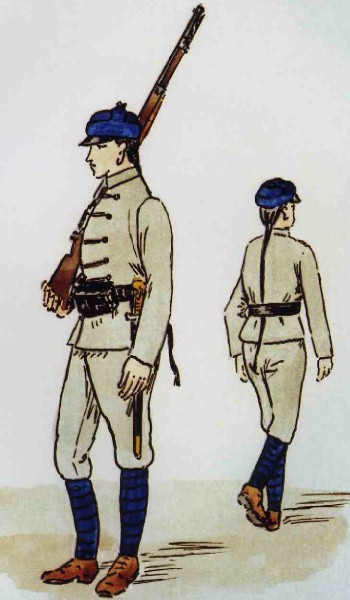Tsingtao Chinese Company
Chinese Soldiers in
German Service 1899-1901 |
 |
 |
 |
 |
Figure 1
Infantryman Chinese Company
Tsingtao c1900 |
Figure 2
Infantryman Chinese Company
Tsingtao c1900 |
Figure 3
Infantryman Chinese Company
Tsingtao c1900 |
Figure 4
Infantryman Chinese Company
Tsingtao c1900 |
|
Background of the Chinese Company
On 19th February 1899
a Chinese Company
("Chinesenkompagnie") was officially formed, consisting of 120 soldiers
and 20 mounted troops
under the command of three German officers and ten NCOs all from the III.
Seebataillon. They were based at Litzun, near Tsingtao
and commanded by Oberleutnant Schoeler. First opinions of the
Chinese troops were high.
Chief of the East Asian Cruiser
Squadron, Otto von Diederichs noted that "the local population would
make really good soldiers" and hoped one day they could be recruited in
large enough numbers to serve in Germany's colonies in Africa ("Askari und Fitafita" by
Thomas Morlang).
They did not live up to these hopes.
Desertion was a common problem. During the Boxer Rebellion
they were considered unreliable and kept away from action. In November
1900 they were
reduced in numbers to
56 infantrymen and 12 mounted troopers.
Even then they were mostly delegated to police or garrison duties. The Chinese Company was
finally disbanded in September 1901.
Uniforms of the Chinese
Company
The uniforms
of the Chinese Company are a difficult topic to study due to a general
shortage of source materials, written or photographic. There is
certainly more to be discovered on this subject.
Summer Uniform
The Summer uniform was khaki, with a standing collar,
no pockets or shoulder straps, five buttons and
simple Chinese
style ties across the breast from each button (some photographs show six
buttons and ties).
Winter Uniforms
The Winter uniform was grey/green with yellow Chinese style braid across
the front and a loop of yellow lace
on the cuff. Matching trousers were worn. Morlang describes the Winter
uniform as being made of corduroy.
Insignia
I have so far not found any NCO rank insignia worn by the Chinese
company in period photographs. Likewise I have not seen any specialist
insignia worn by them. Photographs of their drummer and trumpeter have
no swallows nests.
Headdress
Several types of headdress were worn by the Chinese
company. With the Winter uniform a
grey/green Manchurian peaked cap with ear flaps was worn. I have so far only found one
unclear photograph (published by Morlang) showing this cap and cannot
discern its details.
With the Summer uniform a
Chinese conical straw hat with tassels in the Imperial
colours was worn.
Period photographs show
that the conical hat and Manchurian cap were both worn with the Winter
and Summer uniforms. In some period
photographs a traditional Chinese small peakless black cap with a
pom-pom is worn..
One uniquely Chinese
characteristic was the wearing of their hair long in pigtails
trailing down their backs. The pigtails were then sometimes tucked into
the back of the belt.
Footwear
Trousers (of matching colour to the tunic) were Chinese style,
worn loose at the thigh and close around the calves. Footwear consisted
of short brown leather boots worn with dark blue/grey puttees. Period
photographs also show them wearing Chinese straw soled sandals worn over
white Chinese socks.
Weapons and Equipment
The Chinese company were armed with the Gew88 rifle and S71 bayonet. Their
equipment followed Marine Infantry standards of the time in blackened
leather with 1895
ammunition pouches and the same Imperial belt buckle as the III.
Seebataillon.
Uniforms of the German
Officers and NCOs
The German
officers and NCOs from the III. Seebataillon that commanded
the Chinese company wore standard Marine Infantry uniforms.
| |
|
|
| |
The Illustrations Figure 1 is based on a photograph of a Soldier of the
Chinese Company taken in around 1900. He wears the khaki
Summer uniform, note the five Chinese ties across the breast. He
wears the Manchurian grey/green cap with the ear flaps folded
up. His equipment includes the 1895 pattern ammunition pouches
and Imperial belt buckle and his rifle is the Gew88. He wears
dark blue/grey puttees with Chinese sandals and white socks.
Figure 2 is based on a
photograph of a Soldier of the Chinese Company taken in
around 1900. He wears the same khaki uniform this time with a
small black Chinese peakless cap. He wears no puttees but still
has the Chinese sandals and white socks.
Figure 3 is based on a
photograph of a Soldier of the Chinese Company taken in
around 1900. He wears the same khaki uniform. Note this rear
view shows his pigtail tucked into his belt at the back.
Figure 4 is based on a
photograph of a Soldier of the Chinese Company taken in
around 1900. He wears the grey/green Winter uniform with yellow
braid across the front and loops of yellow lace on the cuffs. He
wears the Chinese conical hat with tassels in the Imperial
colours more usually associated with the Summer uniform. He has
1895 ammunition pouches with a Marine Infantry Imperial belt
buckle and wears brown leather boots with dark blue/grey
puttees. |
|
| |
|
|
| |
|
|
| |

The Chinese Company on Parade
As with most photographs of them, this one does not show the
uniforms very clearly. It seems they wear Chinese caps and the khaki
uniform with puttees. They appear to be unarmed. The Germans wear
standard Seebataillon uniforms- the officer in the foreground wears a white tropical
tunic and cap, possibly with dark blue riding breeches, while the German NCOs wear khaki
uniforms with blue peaked caps and white hatbands and piping.
Photo from
WikiMedia |
|
| |
| |
|
|
|
 |
|
Soldiers of the Chinese Company c1900
Illustration by by
Edgar Graf von Matuschka in
"Deutsche Expeditionstruppen und
Schutztruppen"
They wear the khaki
uniform with Chinese ties and the Manchurian cap here
illustrated in blue/grey whereas sources such as Morlang
describe it as being grey/green to match the winter
uniform. The equipment is in brown leather. Dark blue
grey puttees are worn with brown leather boots.
Note the rear view
showing the pigtail worn tucked into the belt.
This illustration is
clearly based on a nearly identical earlier line drawing
by H Knötel. |
| |
|
|
|
|
|





